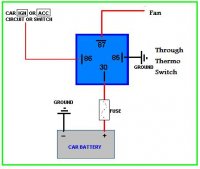Good evening all
Well I replaced the fan with two x 10" thermo fans and updated my thermostat housing and thermostat so that I could house a thermo fan switch. I installed a standard relay and a TFS106 (a thermo fan switch which comes on at 95 degrees celcius and goes off at 90 degrees). The default is open. Anyway I cant get the fans to cut in. I tried another TFS106 and I go the same result. I tried another relay housing and relay and still no success.
The fans come in when I connect them directly to the battery. I have wired the relay as per the following diagram and I have also tried a couple of other combinations, however I still can't get them to kick in. Any ideas?
Well I replaced the fan with two x 10" thermo fans and updated my thermostat housing and thermostat so that I could house a thermo fan switch. I installed a standard relay and a TFS106 (a thermo fan switch which comes on at 95 degrees celcius and goes off at 90 degrees). The default is open. Anyway I cant get the fans to cut in. I tried another TFS106 and I go the same result. I tried another relay housing and relay and still no success.
The fans come in when I connect them directly to the battery. I have wired the relay as per the following diagram and I have also tried a couple of other combinations, however I still can't get them to kick in. Any ideas?


